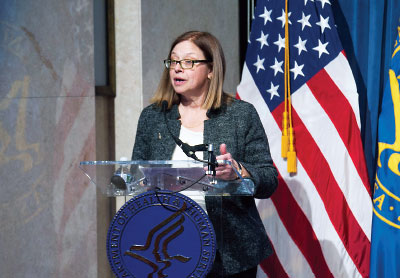The COVID-19 pandemic, the treatment of people with mental illness and substance use disorders (SUDs) who are incarcerated, and clarifications regarding the use of state block grant money were prominent points in a presentation by Elinore McCance-Katz, M.D., Ph.D., the head of the Substance Abuse and Mental Health Services Administration (SAMHSA) and the assistant secretary for mental health and substance use at the virtual APA Spring Highlights Meeting in April.
“SAMHSA has a large role to play in the delivery of services for mental and substance use disorders,” McCance-Katz said. “It is the only federal agency that is charged with reducing the impact of mental illness and substance abuse on American communities.”
McCance-Katz noted that there was an 890% increase in calls to SAMHSA’s Disaster Distress Helpline in March compared with March 2019, and most of the calls were related to COVID-19 (see
Psychiatric News). She outlined the steps SAMHSA is taking during the pandemic to help states address the needs of people with mental illness and SUDs, including advocating for telemedicine and allowing patient information to be shared during medical emergencies under 42 CFR Part 2 at a time when providers may not be able to obtain written patient consent for disclosure of substance use disorder records.
“Early on we were urging the use of telehealth and telemedicine because it was pretty clear that people were not going to be able to see their providers in the way they’d been accustomed to prior to the outbreak of coronavirus,” McCance-Katz said.
McCance-Katz also used the Highlights Meeting presentation to clarify that states may use grant money from SAMHSA to assist and treat people with mental illness or SUDs who are incarcerated.
“There has always been a belief that SAMHSA block grant funds could not be used to provide services to people with serious mental illness if they were incarcerated, but they can be as long as [the services] are provided by community providers who come into the jails and prisons to deliver them,” McCance-Katz explained. She added that engaging this population before they are released lowers their risk of repeat offense, rearrest, and reincarceration. Developing established relationships with mental health professionals while in prison may be particularly important for people with opioid use disorder in maintaining treatment once they are released, she said.
McCance-Katz also clarified new language that has been added to SAMHSA’s grant award notices that requires grantees to certify that they will not use marijuana as a treatment for mental and substance use disorders. She pointed out that at least eight states have put into statute that marijuana is a treatment for opioid use disorder.
“It is not, and federal funds from SAMHSA are not going to be used for that purpose,” McCance-Katz said. “I’m sure that creates some angst in some states, but that is something that we intend to enforce.”
Instead, she emphasized evidence-based practices and treatments, such as medication treatment.
McCance-Katz noted that in Fiscal Year 2020, SAMHSA began allowing states to use funds from State Opioid Response grants to address stimulant use disorder as well as opioid use disorder “depending on the severity of the problem in the state.”
She added that SAMHSA is allowing these funds to be used for programs that provide contingency management treatment. This type of treatment involves giving tangible rewards for not using substances or for attending counseling sessions or completing weekly goals. The rewards might be vouchers for food, movie passes, or other items, or a chance to win cash.
“[Contingency management] is an evidence-based treatment that [before now] has not been used in our funded grant programs,” she said. “We are allowing it because we don’t have medications for stimulant use disorder but we do have a number of studies that show some promise for its use in the context of other evidence-based psychosocial interventions to address stimulant use disorder as well as opioid use disorder.” ■

